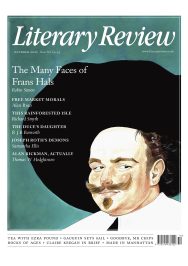Jane O’Grady
The Unbearable Likeness of Being
Understanding Metaphors in the Life Sciences
By Andrew S Reynolds
Cambridge University Press 203pp £34.99
‘In the literal sense of the word, no doubt, natural selection is a false term,’ wrote Darwin in On the Origin of Species. But who, he demanded, objects to the term ‘elective affinities’ in chemistry, or when astronomers pronounce planetary motion to be governed by the ‘attraction of gravity’? Similarly, Darwin observed, ‘it is difficult to avoid personifying the word Nature’ – ‘natural selection’ implies an agent deliberately choosing which specimens shall be born and which survive – but ‘with a little familiarity such superficial objections will be forgotten’. ‘Natural selection’ is itself a metaphor. As Engels pointed out, the term came into being through the transference of the economic theory of competition from society to nature.
Scientific theorising is often criticised for being anthropomorphic. Agency and deliberate intention are ascribed not only to mindless natural processes but also to minuscule parts of organisms – cells, proteins, sperm. Just as often, these are described as storing and transmitting information or as if they were pre-programmed machines. Metaphorical terms are woven so deeply into scientific description as to seem literally accurate. In response, many scientists and philosophers, seeking objectivity, have aimed at creating an ‘ideal language’, each term of which exactly corresponds to a particular ingredient of reality. But that presupposes that there are distinct, mind-independent objects and phenomena which can, in principle, be precisely labelled. Since there aren’t, says Andrew Reynolds, professor of philosophy at Cape Breton University in Canada, science cannot simply hold ‘a mirror up to nature that reflects the objective truth’. Metaphor is indispensable. In any case, scientists aim not so much to describe reality as to chart it, and none of their maps is ‘uniquely correct’. What determines the scale and saliences of each is how usefully it can guide the map-reader, which depends on what the discipline concerned is and what is required to be understood.
Metaphors and analogies make scientific theories intelligible not just to the uninitiated but to the theoriser too. They are often, as Reynolds illustrates, what engender theories in the first place. In trying to make sense of why and how certain species, and not others, develop in certain ways

Sign Up to our newsletter
Receive free articles, highlights from the archive, news, details of prizes, and much more.@Lit_Review
Follow Literary Review on Twitter
Twitter Feed
How to ruin a film - a short guide by @TWHodgkinson:
Thomas W Hodgkinson - There Was No Sorcerer
Thomas W Hodgkinson: There Was No Sorcerer - Box Office Poison: Hollywood’s Story in a Century of Flops by Tim Robey
literaryreview.co.uk
How to ruin a film - a short guide by @TWHodgkinson:
Thomas W Hodgkinson - There Was No Sorcerer
Thomas W Hodgkinson: There Was No Sorcerer - Box Office Poison: Hollywood’s Story in a Century of Flops by Tim Robey
literaryreview.co.uk
Give the gift that lasts all year with a subscription to Literary Review. Save up to 35% on the cover price when you visit us at https://literaryreview.co.uk/subscribe and enter the code 'XMAS24'